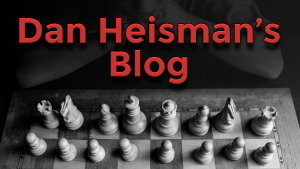How USCF Rule 29L1 got Changed
Alert: If you are interested in how rules get changed and/or tournament pairings get made, this article should prove fairly entertaining. If not, then just skip it, as the story may not be your cup of tea  .
.
Our Main Line Chess Club runs ongoing USCF-rated tournaments that last for five Tuesdays, and then we start another tournament. Except for our club championship, there are no prizes, so we can do things like give players who do not show up on a given week an appropriate bye. That way a master who does not play for the first four weeks would be given a 4-0 record, and can play an appropriately difficult opponent if he shows for Round 5. Ditto for anyone missing rounds - they get the score which they would probably have made if they had been there.
A few months ago one of our TDs, Al Pearson, suggested that we try the USCF "1 vs 2" pairing system, Rule 29L1, for a tournament or two. The idea of this alternative system is to ensure the closest possible matchups each round, unlike the normal Swiss System, which has as its core bringing the cream to the top. One point, which turned out to be important, was the Rule 29L1 specified that the "odd man rule" be handled exactly like in regular swiss system pairings. Let me explain:
Example 1: Swiss Pairings
In a normal swiss, the top half of each pairing group gets paired with the lower half. Suppose the Top 8 players A-H (in score, not in rating) in a Swiss-paired event with many players have the following ratings and scores after 4 rounds:
1. Player A 2236 4 points
2. Player B 2155 4 points
3. Player C 1856 4 points
4. Player D 2311 3.5 points
5. Player E 2241 3.5 points
6. Player F 2111 3.5 points
7. Player G 1952 3.5 points
8. Player H 2187 3 points
Then let's assume the colors work out for the pairings. We might see the Swiss pairings for Round 5:
Board 1: Player A paired vs Player B
...but what about the "odd" leader Player C?
On Board 2 C would get paired with the highest rated player in the 3.5 group, Player D.
The idea would be to give Player C the most difficult possible opponent so that the fewest number of players would likely have a perfect score and a winner could be determined. The other pairings might be:
Board 3 Player E vs Player F
...and the "odd" one at 3.5,
Board 4 Player G, paired down to the top rated player with 3, Player H.
So far, so good. Swiss ideas: H and D are favorites to help the cream rise to the top.
Example 2: "1 vs 2" pairing, current rulebook wording:
But in the "1 vs 2" pairing system the top half does not play the bottom half like it does in a swiss system. Instead the lower players mostly play themselves until they win enough games to be forced to be paired with a higher player. So a similar tournament, ,but run under the "1 vs 2", might find the Top 8 players (plus Player 14) look something like this:
1. Player A 2245 4 pts
2. Player B 1811 4 pts
3. Player C 1321 4 pts
4. Player D 2330 3.5 pts
5. Player E 2245 3.5 pts
6. Player F 1711 3.5 pts
7. Player G 1323 3.5 pts
8. Player H 2176 3 pts
...
14. Player N 1256 3 pts
Using the Rulebooks Rule 29L1 "1 vs 2" pairing with the same "odd man" pairing rule as in Example 1, we might see
Board 1: Player A 2245 vs Player B 1811
Board 2: Player C 1321 vs Player D 2330
Board 3: Player E 2245 vs Player F 1711
Board 4: Player G 1323 vs Player H 2176 etc.
These are great pairings under the swiss system where we are trying to knock down Player C and Player G by giving them the most difficult possible opponents from the next lower score group. But they are terrible pairings if you want to use the philosophy of "1 vs 2" where you are trying to find the most equal opponents and most competitive games.
So I made a proposed change to the USCF that we modify Rule 29L1 so that the odd man in a score group would be paired with the most appropriate player (taking into account normal color rules) at the next pairing group.
Example 3: "1 vs 2" pairing, proposed rulebook change:
Using the same players as in Example 2, the proposed rule would make the Round 5 "1 vs 2" pairings look something like:
Board 1: Player A 2245 vs Player B 1811
Board 2: Player C 1321 vs Player G 1323 (the most appropriate 3.5)
Board 3: Player E 2245 vs Player D 2330
Board 4: Player G 1323 vs Player N 1256 (the most appropriate 3)
Board 5: Player H 2176 vs Player I, etc.
This means Boards 2 and 4 are paired much differently with competitive games, the entire idea of the "1 vs 2" scoring system.
When I proposed this rule change to USCF, based on what had happened at our Main Line Chess Club, I expected it to pass as a "no brainer". After all, we had tried the rarely-used rule, found an obvious flaw, and the solution was rather logical and easy. Moreover, who else would care about this rare rule? They would pass it since no one would care to oppose it.
Imagine my surprise when, after I proposed the rule change, that in some quarters it was met by violent opposition. This opposition was especially vocal by an experienced and influential USCF TD who, if I remember correctly, admitted he had never used the "1 vs 2" system but argued mightily (and surprisingly) that the current wording was much superior! We finally agreed to disagree (at least I did...).
I was not planning to attend the USCF's annual meeting in Aug 2013, when this proposed change would be decided. So, when I made this proposal in the spring, I searched for someone to be an onsite "champion" of the proposed change at the Delegates Meeting. However, after a few attempts, I could not find anyone who was going to attend and was willing to help. Therefore, I surmised that, without me there to explain and support the proposed change, it would die on the vine. Oh well, I tried; their problem, but this rare pairing rule would not affect very many. The Main Line CC could still pair 29L1 the way we had fixed it - that would still be legal as long as we told everyone in advance (no one at our club cared that much either!). Then I forgot the whole thing.
But tonight, out of the blue, I got an email from TD Tim Just, the co-editor of USCF Rulebook V - he said my motion had passed! How could that be? I emailed Tim back and wrote "I thought it would die without a live champion." Tim replied "I was the live champion - you can watch it on YouTube!" 
That was the unexpected news I got from the USCF meetings. The expected news was how my The World's Most Instructive Amateur Game Book fared in the Chess Journalists of America's Book of the Year voting. It was the only category for which I was entered this year (Multi-award winner Novice Nook was taking the year off) Haven't heard about that one yet...
PS: Al gave up on the "1 vs 2" idea after we tried it for a couple of events (even with the fix!) and we went back to Swiss "Accelerated" pairings.
PPS: My book did not win, but my publisher Mongoose Press won anyway for another book, Amateur to IM by Jonathan Hawkins. Congrats to both!

